Cheap Alternative to Garage Door – Searching for a cost-effective substitute for a garage door? Look no more! We have a solution that won’t hurt your wallet. Regular garage doors can be pricy, but there are other choices out there that grant both utility and affordability.
One example is a roll-up door. These doors are made of strong materials and are built to fit flawlessly into smaller spaces. Roll-up doors are practical and economical, offering security while saving space compared to conventional garage doors. They are commonly used in commercial settings but can also work well for residential properties.
If you’re seeking an even more budget-friendly alternative, think about using curtains or screens to make a barrier between your garage and the outside world. This DIY approach allows you to separate the area while still permitting airflow and natural light.
1. Curtain-style Roll-Up Door – Cheap Alternative to Garage Door
A curtain-style roll-up door, also known as a roll-up garage door or rolling door, is a type of garage door that is characterized by its vertical operation, where the door rolls upward and is stored in a coil or roll above the opening. These doors are often used in commercial and industrial settings, but they can also be found in some residential garages, especially those with limited space or budget constraints.
Here are some key features and details about curtain-style roll-up doors:
Features and Characteristics:
- Vertical Operation: Instead of swinging outward or sliding to the side like traditional garage doors, roll-up doors roll vertically upward, saving space both inside and outside the garage.
- Materials: Roll-up doors are typically made of durable materials like steel, aluminum, or fiberglass. The choice of material affects factors such as durability, security, and insulation.
- Manual or Motorized: Roll-up doors can be operated manually by pulling a chain or crank, or they can be motorized for convenient remote control or keypad access.
- Security: While not as secure as solid sectional doors, roll-up doors can provide a reasonable level of security when constructed from sturdy materials. Some roll-up doors have built-in locking mechanisms for added security.
- Insulation: Insulation options vary. Some roll-up doors offer insulation to help regulate temperature within the garage, while others may provide minimal insulation.
Advantages:
- Space-Saving: Roll-up doors are excellent for garages with limited headroom or for those who need to maximize available space.
- Durability: They are known for their durability and resistance to harsh weather conditions.
- Affordability: Roll-up doors are often more affordable than traditional sectional garage doors.
- Easy Operation: Motorized roll-up doors can be opened and closed with the push of a button, offering convenience.
Disadvantages:
- Limited Insulation: Depending on the model, roll-up doors may not offer the same level of insulation as traditional garage doors, which can affect energy efficiency.
- Limited Design Options: They may not come in as many design and style options as sectional doors, limiting aesthetic choices.
- Security: While they can provide security, they may not be as secure as solid sectional doors.
Roll-up doors are a practical choice for garages where space and budget considerations are important. However, it’s essential to choose a high-quality, properly insulated model if you live in an area with extreme temperatures. Additionally, consider your security needs and whether a roll-up door meets them adequately. If aesthetics and curb appeal are crucial, you may need to explore other garage door options.
- Price Range: $100 to $500 or more, excluding installation.
- Installation costs can vary, but they are generally less expensive than traditional garage door installation.
2. Sliding Barn Door – Cheap Alternative to Garage Door

Sliding barn doors are a popular architectural and design feature that originated from traditional farm and barn buildings. They have gained popularity in various settings, including homes, commercial spaces, and interior design projects. Here’s a more detailed explanation of sliding barn doors:
Features and Characteristics:
- Sliding Mechanism: Sliding barn doors are designed to move horizontally along a track. They do not swing open like traditional hinged doors. The track system can be mounted either on the exterior or hidden within the wall, depending on your design preference.
- Materials: Sliding barn doors are typically constructed from wood, but they can also be made from metal, glass, or a combination of materials. The choice of material depends on the desired aesthetics and functionality.
- Aesthetic Appeal: One of the main reasons for the popularity of sliding barn doors is their rustic and visually appealing design. They often feature decorative hardware, such as handles, rollers, and brackets, that enhance their farmhouse or industrial look.
- Customization: Sliding barn doors can be customized to match the overall design and decor of a space. You can choose different types of wood, finishes, paint colors, and hardware to create a unique look.
- Space-Saving: Since they don’t swing open, sliding barn doors are an excellent space-saving solution, making them suitable for rooms with limited space or awkward layouts.
- Versatility: Sliding barn doors are not limited to exterior or interior doors. They are also used for room dividers, closets, and even as decorative elements.
Advantages:
- Aesthetic Appeal: Sliding barn doors add a unique and rustic touch to any space, making them a popular choice for both modern and traditional interior design.
- Space Efficiency: They are perfect for areas where traditional swinging doors would be impractical due to space constraints.
- Customization: You can personalize sliding barn doors to suit your style and preferences.
- Quiet Operation: When properly installed, sliding barn doors can move quietly along their tracks.
Disadvantages:
- Limited Privacy: Sliding barn doors do not provide as much privacy as solid-hinged doors because there may be gaps between the door and the wall when closed.
- Installation Complexity: Installing sliding barn doors, especially if you’re retrofitting them into an existing space, can be more involved than installing traditional doors. Proper installation is essential to ensure smooth operation.
- Maintenance: Depending on the material and finish, sliding barn doors may require periodic maintenance, such as resealing or repainting.
Sliding barn doors can be a beautiful and practical addition to your home or commercial space, offering a unique blend of functionality and design aesthetics. When considering sliding barn doors, it’s essential to think about your specific needs, the available space, and the overall style you want to achieve. Proper installation and maintenance will ensure they function smoothly and remain visually appealing over time.
- Price Range: $200 to $1,000 or more, excluding installation.
- DIY construction can save money on materials, but professional installation may increase the cost.
3. Accordion-style Folding Door
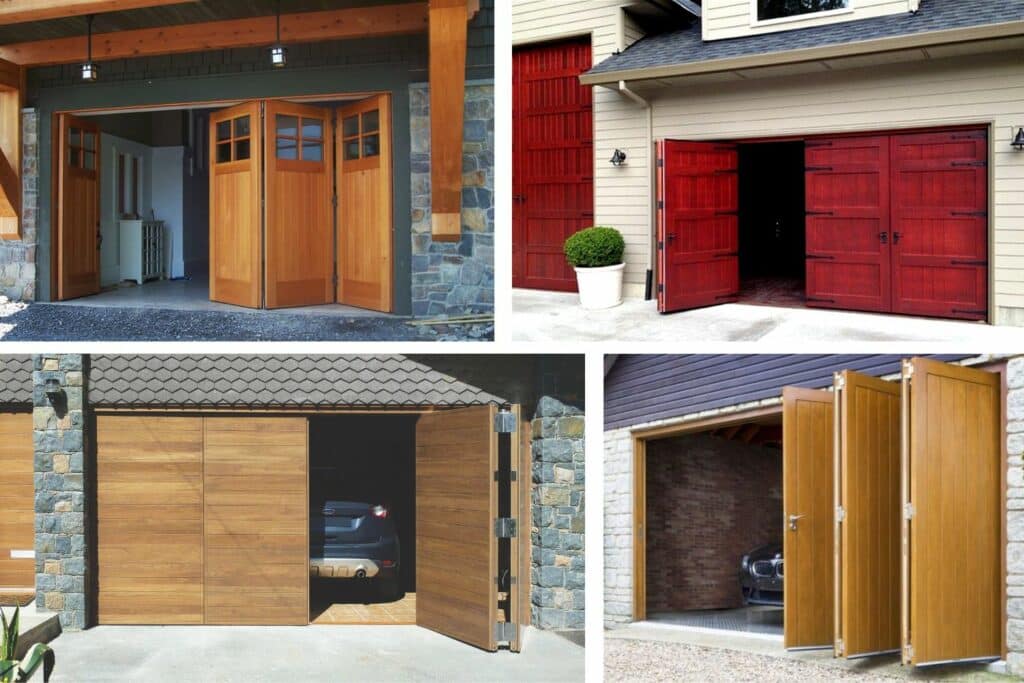
Accordion-style folding doors, also known as folding doors, accordion doors, or bi-fold doors, are a versatile and space-saving door solution used in both residential and commercial settings. Here’s a more detailed explanation of accordion-style folding doors:
Features and Characteristics:
- Folding Design: Accordion doors consist of multiple panels connected by hinges. These panels fold together in a zigzag or accordion-like fashion when the door is opened and stretch out to form a straight barrier when closed.
- Materials: They can be made from various materials, including wood, vinyl, aluminum, glass, or a combination of these materials. The choice of material influences factors such as aesthetics, durability, and insulation.
- Configurations: Accordion doors come in different configurations, allowing you to choose the number of panels and their width to suit the opening you want to cover. Common configurations include two-panel, three-panel, and four-panel doors.
- Operation: Accordion doors are designed to be easy to operate. They typically have a track system at the top and bottom that guides the panels as they fold and unfold. Some models can be operated manually, while others come with motorized options for remote control.
- Aesthetic Options: Depending on the material used, you can customize the appearance of accordion doors with various finishes, colors, and patterns. Glass accordion doors are popular for their modern and sleek look, while wooden ones provide a more traditional or rustic appearance.
Advantages:
- Space Efficiency: Accordion doors are ideal for spaces where traditional swinging doors would take up too much room when open.
- Flexible Room Dividers: They can serve as room dividers, allowing you to open up or close off spaces as needed, making them popular in open-concept living areas.
- Customization: You can choose the number of panels and materials to match your aesthetic preferences and the specific requirements of your space.
- Natural Light: Glass accordion doors allow natural light to flow through, creating a bright and airy atmosphere when closed.
Disadvantages:
- Limited Sound and Thermal Insulation: Depending on the material and design, accordion doors may not provide the same level of soundproofing or insulation as solid walls or doors.
- Maintenance: Some materials, like wood, may require regular maintenance, such as staining or sealing.
- Cost: Higher-quality accordion doors with features like insulated glass or premium materials can be relatively expensive.
Accordion-style folding doors are a versatile and aesthetically pleasing solution for those seeking a space-saving and flexible way to divide or connect rooms. They are particularly well-suited for areas where you want to maintain an open feel but also have the option to create separate zones when necessary. When considering accordion doors, consider factors such as material choice, customization options, and the overall style of your space to ensure they meet your needs and design preferences.
- Price Range: $300 to $800 or more, excluding installation.
- Installation costs can vary depending on complexity.
4. Plywood or OSB Board Door
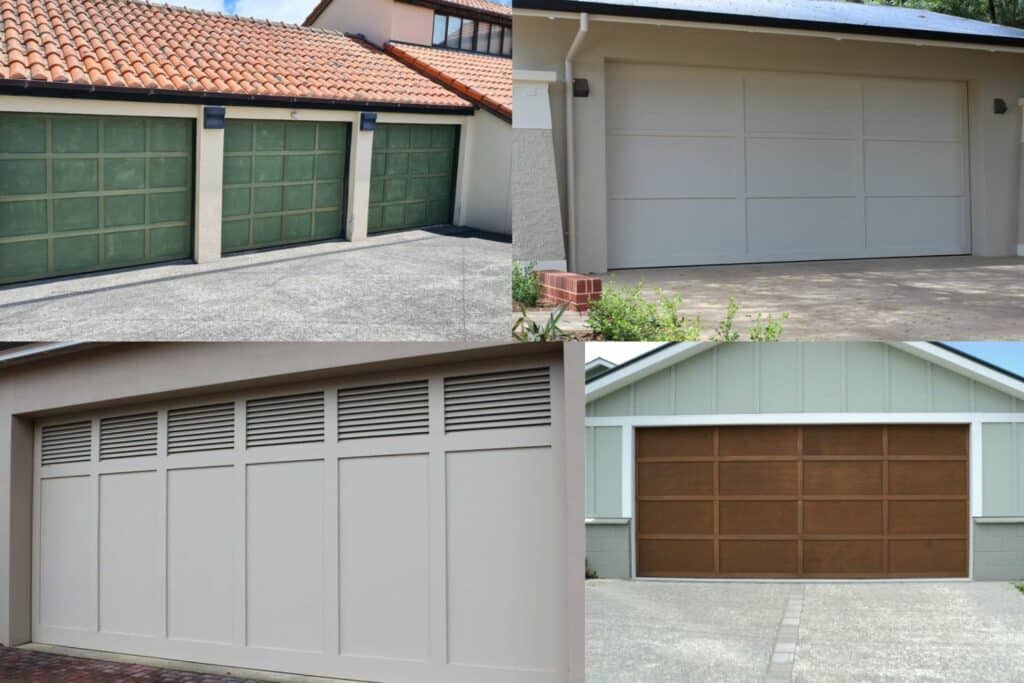
Plywood or OSB (Oriented Strand Board) board doors are simple, budget-friendly alternatives to traditional garage doors. These doors are often used as temporary or makeshift solutions, and they are typically constructed from basic building materials. Here’s a more detailed explanation of plywood or OSB board doors:
Features and Characteristics:
- Materials: Plywood and OSB are engineered wood products made by compressing wood fibers or strands together with adhesive. Both materials are relatively inexpensive and readily available at hardware stores. Plywood is made from thin layers of wood veneer, while OSB is composed of wood strands layered in a crisscross pattern.
- Construction: Plywood or OSB board doors are typically constructed by cutting the sheets to the desired size and attaching them to a frame made of lumber. The frame provides stability and structure to the door.
- Design Simplicity: These doors are typically designed for basic functionality rather than aesthetics. They are often a single, solid panel without any decorative features.
- Operation: These doors are usually hinged on one side and swing open manually, similar to a traditional hinged door. They may have basic handles or pulls for easy operation.
Advantages:
- Low Cost: Plywood and OSB are among the most budget-friendly building materials, making these doors an affordable option.
- Customization: You can easily customize the size and shape of plywood or OSB board doors to fit your garage’s dimensions.
- DIY-Friendly: These doors are relatively simple to construct, making them suitable for DIY projects.
Disadvantages:
- Limited Durability: Plywood and OSB are not as durable as other garage door materials like steel or aluminum. They are susceptible to damage from moisture, pests, and physical impacts.
- Minimal Security: These doors offer limited security and may not deter break-ins as effectively as more robust garage doors.
- Limited Insulation: Plywood and OSB board doors provide minimal insulation, which can result in poor temperature control inside the garage.
Maintenance: Over time, plywood and OSB board doors may require maintenance, such as sealing or painting, to protect against moisture and decay.
Plywood or OSB board doors are typically used in situations where cost is the primary concern, and long-term durability and aesthetics are not a high priority. They can be suitable for temporary garage enclosures or for situations where the garage is used mainly for storage and protection from the elements. However, it’s important to recognize their limitations, especially in terms of security and insulation, and to consider your specific needs and budget when choosing this type of garage door alternative.
- Price Range: $50 to $200 or more, excluding installation.
- This is one of the most budget-friendly options, but it may not provide insulation or security.
5. Curtains or Tarps
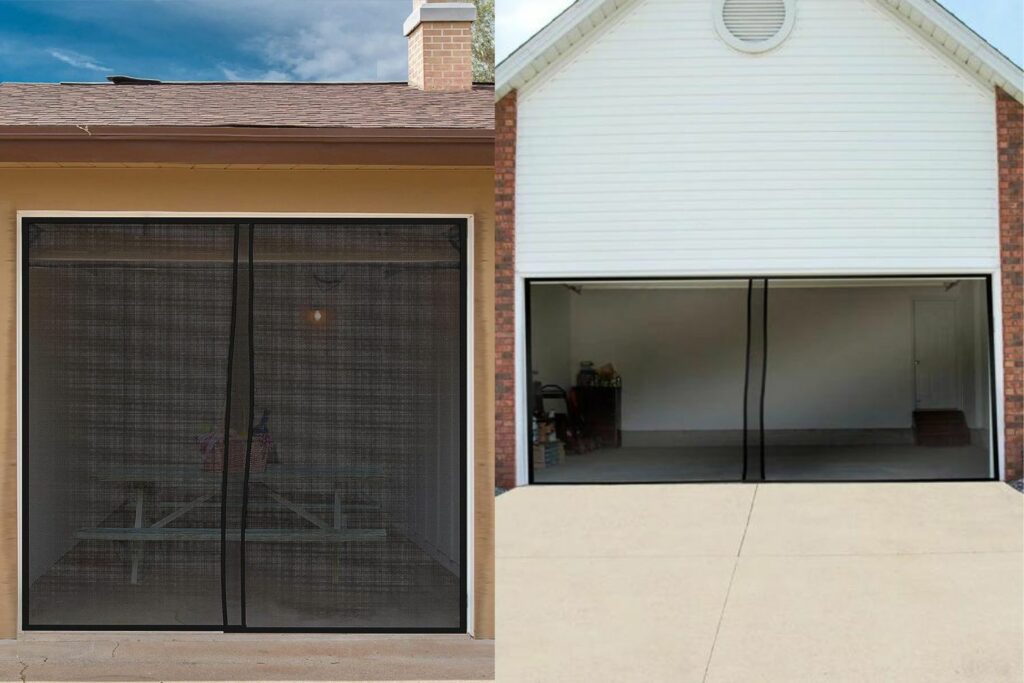
Curtains or tarps are among the simplest and most cost-effective solutions for temporarily covering garage openings or creating barriers. They are typically used when a more permanent or substantial garage door is not necessary or when budget constraints are a primary concern. Here’s a more detailed explanation of curtains or tarps as garage door alternatives:
Features and Characteristics:
- Materials: Curtains used as garage door alternatives are often made from heavy-duty fabric, vinyl, or tarpaulin materials. These materials are chosen for their durability and weather-resistant properties.
- Construction: Garage curtains or tarps are typically attached to a frame or structure surrounding the garage opening. They can be secured in place with fasteners, snaps, grommets, or hooks, allowing for easy installation and removal.
- Operation: Curtains or tarps can be manually pulled open or closed as needed. They are often rolled or folded when not in use, and some systems may have a pulley or roller mechanism for easier operation.
- Customization: These garage door alternatives can be customized in terms of size, color, and material thickness to suit specific requirements.
Advantages:
- Affordability: Curtains and tarps are one of the most budget-friendly options for covering a garage opening or creating a temporary barrier.
- Ease of Installation: They are relatively simple to install and can be done as a DIY project, saving on installation costs.
- Flexibility: Curtains or tarps can be easily opened or closed to provide access to the garage space when needed.
- Space-Saving: When not in use, they can be neatly rolled or folded to save space.
Disadvantages:
- Limited Security: Curtains or tarps offer minimal security and can be easily breached, making them unsuitable for situations where security is a concern.
- Limited Weather Protection: While they provide some protection against rain, wind, and dust, they may not offer the same level of weather resistance as more robust garage doors.
- Limited Insulation: Curtains or tarps provide little to no insulation, which can result in poor temperature control inside the garage.
Maintenance: Over time, curtains or tarps may require cleaning, repairs, or replacement due to wear and tear.
Curtains or tarps are typically used in situations where the garage is primarily used for storage or as a temporary workspace and where security and weather protection are not critical. They are common in commercial or industrial settings where rapid access to the garage is needed. However, for residential use, especially when security and insulation are important, more substantial garage door options are usually recommended.
- Price Range: $20 to $100 or more, excluding installation.
- These are the cheapest options but offer minimal security and weather protection.
Conclusion
In summary, while these alternative garage door options may be cheaper, they often come with trade-offs in terms of durability, security, insulation, and weather protection. The choice depends on your specific needs, budget constraints, and how you intend to use your garage. If security, insulation, and weather protection are critical, investing in a traditional garage door may be a better long-term solution.
Frequently Asked Questions
FAQs on Cheap Alternatives to Garage Doors:
1. Q: Are these alternatives as secure as regular garage doors?
A: While some alternatives may not offer the same level of security as traditional garage doors, measures can be taken to enhance security, such as using sturdy materials, adding locks, or installing motion-sensor lights.
2. Q: Can these alternatives be DIY projects?
A: Many of these alternatives can be DIY projects, depending on your skill level and the complexity of the chosen option. However, it’s advisable to consult with professionals for installation to ensure safety and proper functionality.
3. Q: Will opting for a cheap alternative affect the curb appeal of my home?
A: While some alternatives may not offer the same aesthetic appeal as traditional garage doors, there are various designs and finishes available that can complement the overall look of your home. Researching different options can help you find one that suits your style.
4. Q: Are there any maintenance requirements for these alternatives?
A: The maintenance requirements vary depending on the chosen alternative. However, regular cleaning, lubrication of moving parts, and occasional repairs might be necessary to ensure their longevity and proper functioning.
5. Q: Is it worth considering these alternatives for cost savings?
A: Opting for cheap alternatives to garage doors can be a cost-effective solution, especially if you have budget constraints. However, it is essential to weigh the benefits against potential drawbacks, such as reduced security or limited insulation, before making a decision – Cheap Alternative to Garage Door
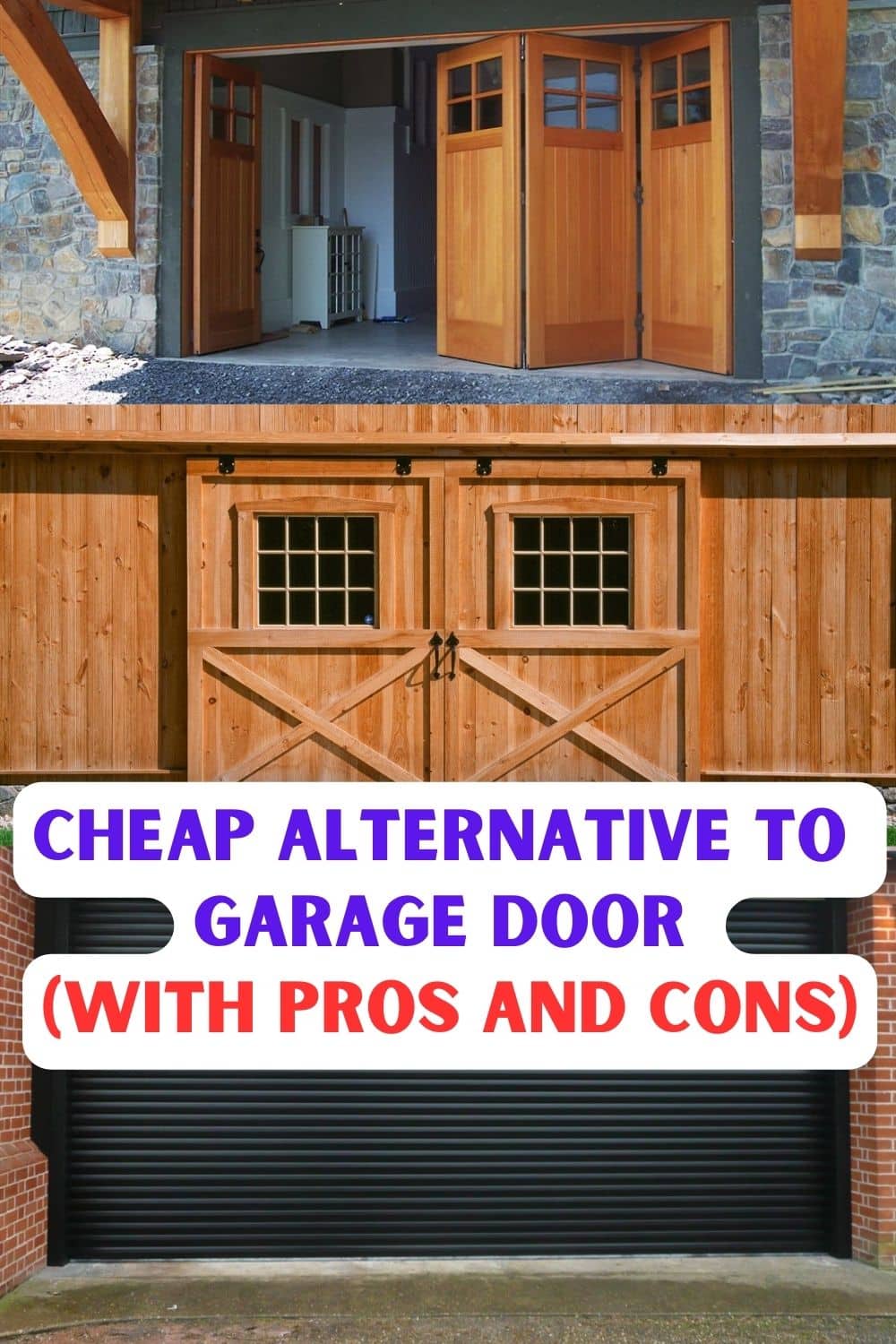


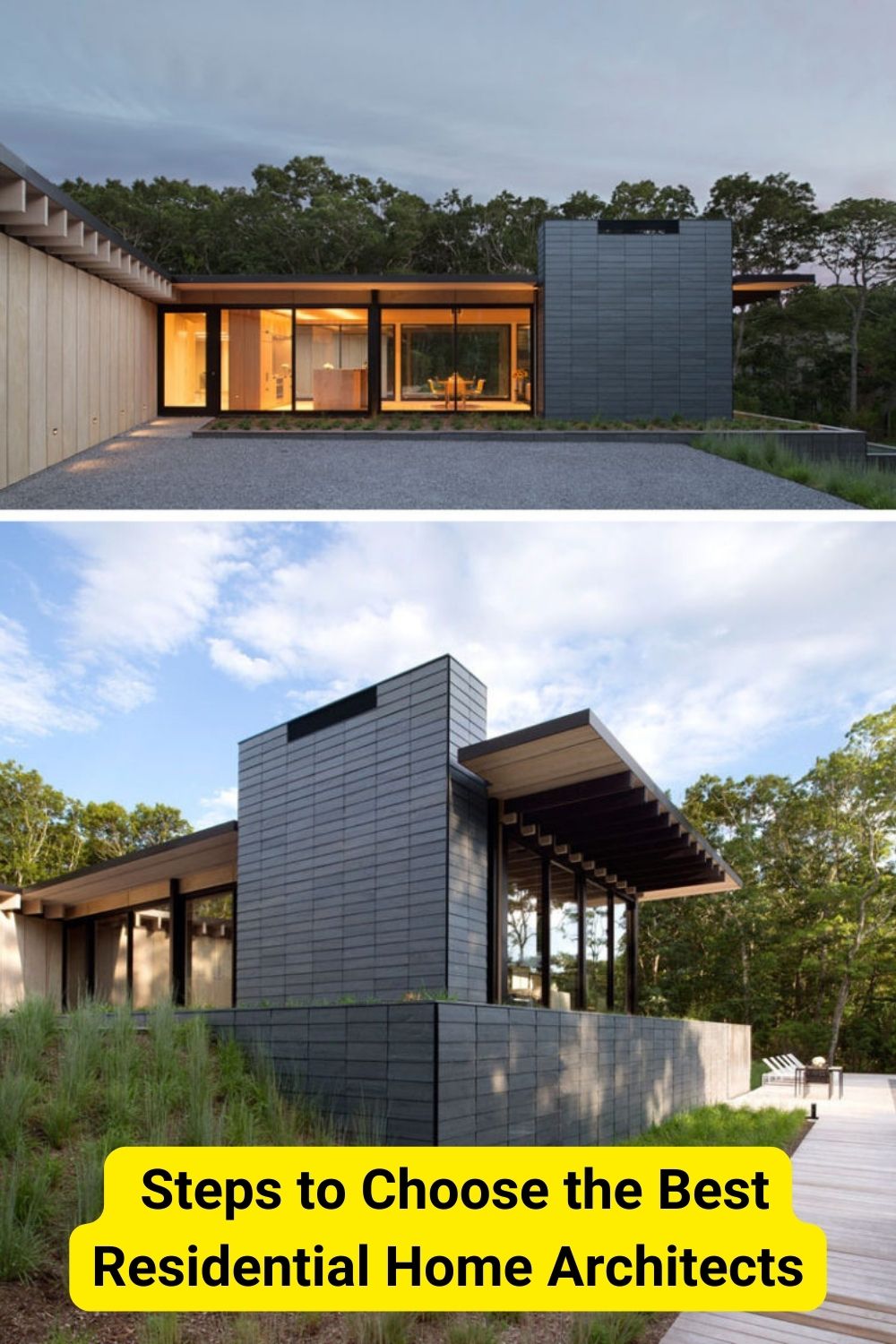

Leave a Reply